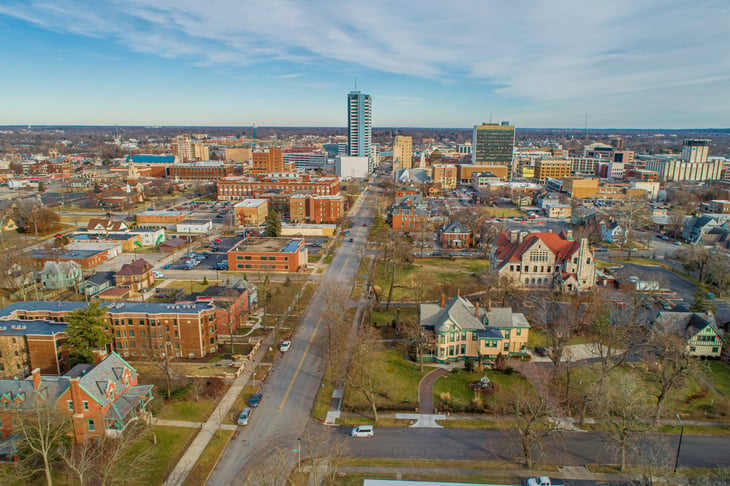
Editor's Note: This story originally appeared on Upgraded Points.
When the COVID-19 pandemic arrived in the U.S. at the beginning of 2020, quarantine and social distancing regulations caused consumer behaviors to change dramatically.
Many stores and restaurants were required to close down temporarily and only reopen with limited capacity and increased safety regulations.
As a result, many Americans were able to save money during the pandemic.
When stimulus checks and other financial relief began reaching bank accounts — from the first payment in March 2020 to the third round in March 2021 — many households were able to improve their financial situations by increasing savings and paying down debt.
Many COVID-19 regulations and relief options varied by state, leading to varied financial impacts around the country.
Here is a breakdown of the U.S. states with the biggest increase in credit scores during the pandemic.
1. Idaho

- Percentage Change in Average Credit Score (2019–2022): +2.3%
- Total Change in Average Credit Score (2019–2022): +16
- Average Credit Score in 2022: 727
- Average Credit Score in 2019: 711
- Average Household Debt-to-income Ratio (2022): 2.157
2. Alaska

- Percentage Change in Average Credit Score (2019–2022): +2.3%
- Total Change in Average Credit Score (2019–2022): +16
- Average Credit Score in 2022: 723
- Average Credit Score in 2019: 707
- Average Household Debt-to-income Ratio (2022): 1.721
3. Arizona

- Percentage Change in Average Credit Score (2019–2022): +2.3%
- Total Change in Average Credit Score (2019–2022): +16
- Average Credit Score in 2022: 712
- Average Credit Score in 2019: 696
- Average Household Debt-to-income Ratio (2022): 1.967
4. Nevada

- Percentage Change in Average Credit Score (2019–2022): +2.3%
- Total Change in Average Credit Score (2019–2022): +16
- Average Credit Score in 2022: 702
- Average Credit Score in 2019: 686
- Average Household Debt-to-income Ratio (2022): 1.889
5. South Carolina

- Percentage Change in Average Credit Score (2019–2022): +2.2%
- Total Change in Average Credit Score (2019–2022): +15
- Average Credit Score in 2022: 696
- Average Credit Score in 2019: 681
- Average Household Debt-to-income Ratio (2022): 1.918
6. Utah

- Percentage Change in Average Credit Score (2019–2022): +2.0%
- Total Change in Average Credit Score (2019–2022): +14
- Average Credit Score in 2022: 730
- Average Credit Score in 2019: 716
- Average Household Debt-to-income Ratio (2022): 1.957
7. Oregon

- Percentage Change in Average Credit Score (2019–2022): +1.9%
- Total Change in Average Credit Score (2019–2022): +14
- Average Credit Score in 2022: 732
- Average Credit Score in 2019: 718
- Average Household Debt-to-income Ratio (2022): 1.839
8. Delaware

- Percentage Change in Average Credit Score (2019–2022): +1.9%
- Total Change in Average Credit Score (2019–2022): +13
- Average Credit Score in 2022: 714
- Average Credit Score in 2019: 701
- Average Household Debt-to-income Ratio (2022): 1.660
9. Indiana

- Percentage Change in Average Credit Score (2019–2022): +1.9%
- Total Change in Average Credit Score (2019–2022): +13
- Average Credit Score in 2022: 712
- Average Credit Score in 2019: 699
- Average Household Debt-to-income Ratio (2022): 1.356
10. Florida

- Percentage Change in Average Credit Score (2019–2022): +1.9%
- Total Change in Average Credit Score (2019–2022): +13
- Average Credit Score in 2022: 707
- Average Credit Score in 2019: 694
- Average Household Debt-to-income Ratio (2022): 1.845
11. North Carolina

- Percentage Change in Average Credit Score (2019–2022): +1.9%
- Total Change in Average Credit Score (2019–2022): +13
- Average Credit Score in 2022: 707
- Average Credit Score in 2019: 694
- Average Household Debt-to-income Ratio (2022): 1.658
12. West Virginia

- Percentage Change in Average Credit Score (2019–2022): +1.9%
- Total Change in Average Credit Score (2019–2022): +13
- Average Credit Score in 2022: 700
- Average Credit Score in 2019: 687
- Average Household Debt-to-income Ratio (2022): 1.337
13. New Mexico

- Percentage Change in Average Credit Score (2019–2022): +1.9%
- Total Change in Average Credit Score (2019–2022): +13
- Average Credit Score in 2022: 699
- Average Credit Score in 2019: 686
- Average Household Debt-to-income Ratio (2022): 1.661
14. Texas

- Percentage Change in Average Credit Score (2019–2022): +1.9%
- Total Change in Average Credit Score (2019–2022): +13
- Average Credit Score in 2022: 693
- Average Credit Score in 2019: 680
- Average Household Debt-to-income Ratio (2022): 1.343
15. Mississippi

- Percentage Change in Average Credit Score (2019–2022): +1.9%
- Total Change in Average Credit Score (2019–2022): +13
- Average Credit Score in 2022: 680
- Average Credit Score in 2019: 667
- Average Household Debt-to-income Ratio (2022): 1.552
Methodology

The data used in this analysis is from Experian’s “What Is the Average Credit Score in the U.S.?” research and the Board of Governors of the Federal Reserve System’s Household Debt dataset.
To determine the states with the biggest increase in credit scores during the COVID-19 pandemic, researchers at Upgraded Points calculated the change in average credit score from full-year 2019 to September 2022.
In the event of a tie, the state with the greater total change in average credit score during the same time period was ranked higher.





Add a Comment
Our Policy: We welcome relevant and respectful comments in order to foster healthy and informative discussions. All other comments may be removed. Comments with links are automatically held for moderation.